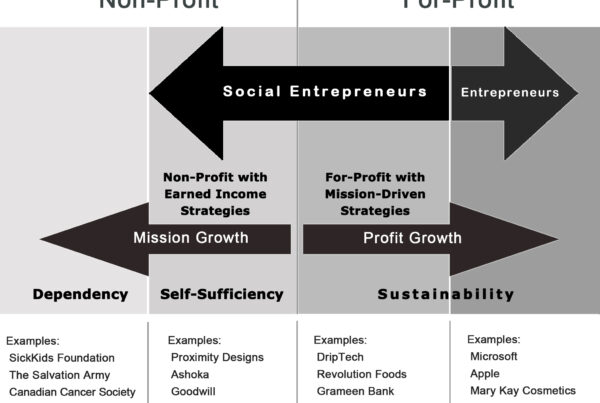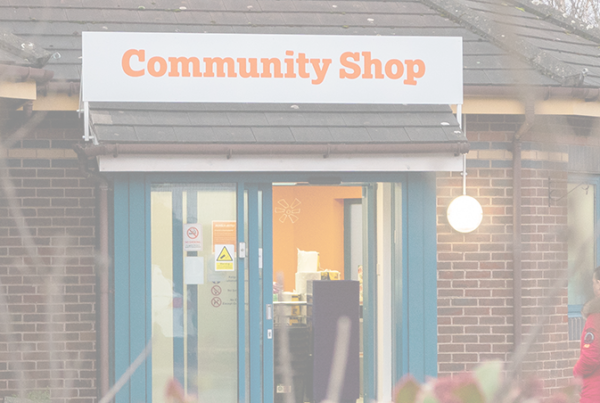Source: Adam G. Force In Impact Models
A business model is a structure, design or framework that a business follows to bring value to its customers and clients. However, there are at least three measures of the success of a business model—its ability to generate profit for its owners, its ability to generate positive change in the world, and its ability to achieve a balance of profit and positive change. The first approach applies to traditional for-profit companies; the second approach applies to traditional charities; and the third approach (a balance between profit and positive change) applies to social enterprises.
Given the definition above, a social business model is a structure, design or framework that a social business follows in order to bring about a positive change while maintaining healthy financial returns. Yet despite sharing this basic framework, social entrepreneurs have a wide spectrum of viable social business models to choose from.
To help shed light on that spectrum, in 2012 Wolfgang Grassi (aka W. Grassi) identified nine types of social business models. He began his analysis with three factors guiding any social business: the mission, the type of integration, and the target population. He then explored the way in which these three factors intersected with the three traditional categories of business (for-profit, not-for-profit and hybrids) to generate the nine specific types of social business models that any social enterprise could adopt.
Let’s have a look at them:
- The Entrepreneur Support Model
This model of social enterprise (SE) sells business support services directly to the entrepreneurs in its target population. In other words, this type of SE helps entrepreneurs get their businesses off the ground. Support can come in the form of consulting services, training, microfinancing or technical support. Organizations that belong to this category may include economic development organizations, business development service organizations and microfinancers.
Examples to Inspire:
- Interview with Rick Alexander: Everything You Need to Know About Benefit Corporations and Legal Structures
- Interview with Kelly Campbell: How She Sold Her Second Company and Created a New Meaningful Business She Loves
- 10 Business Lessons from the Head of Legal Policy at B Lab
- Interview with Ryan Foland: How Mastering Communication Can Change Your Life
- The Market Intermediary Model
This type of SE generally helps their clients by marketing or selling their clients’ products or services for them. For example, an organization that helps struggling small farmers by marketing and to sell their crops for them would belong to this category.
Want to dig in right now and figure out your impact model? We love this book: Business Model Generation: A Handbook for Visionaries, Game Changers, and Challengers which is a great tool, resource and guide to get you started!
- The Employment Model
This type of SE provides their clients with job opportunities and job training. Revenue generated by those jobs pays for the SEs expenses and flows back into the services provided for those in need. Many youth and disabilities organizations adopt this model.
Examples to inspire you:
- Nasreen Sheikh: From Child Slave to Powerful Social Entrepreneur Helping Women Escape Poverty
- Sydney Sherman: How to Build an Online Marketplace that Combats Poverty Through the Things We Buy
- How These 4 Social Entrepreneurs Are Hacking Away at Poverty
- If You Like Flip Flops Than Here’s How You Can Change a Life Buying a Pair
- Top 7 Socially Aware Clothing Companies to Watch Out For
- Miscoots: How this Hip Clothing Brand is Disrupting Homelessness
- The Fee-for-Service Model
The fee-for-service model is one of the most commonly adopted SE business models. The SE charges the customer directly for the socially beneficial services it provides. Many hospitals, schools, museums and membership organizations use the fee-for-service model to a greater or less degree.
Examples to Inspire You:
- University of the Future: The Sustainable Education Model
- 3 Social Entrepreneurs Blazing New Trails Toward Sustainability
- The Low-income Client Model
SEs in this category generally offer social services directly (as in the fee-for-service model) while focusing on low-income clients. Hospitals and healthcare programs that offer their healthcare services to low-income patients often adopt this model.
- The Cooperative Model
This is one of the most widely recognized categories of SE. The cooperative is generally a fee-based membership organization that provides member services to a group that shares a common need or goal. The cooperative is owned and operated by its members, who both run the cooperative and receive the benefits of its success. Two of the most well-known types of cooperative include credit unions and employee-owned businesses (“co-ops”).
- The Market Linkage Model
SEs that serve as brokers for their clients often adopt this model. These SEs focus on building relationships and otherwise connecting their clients with markets for their clients’ products and services. However, unlike SEs adopting the market intermediary model, these SEs generally do not market or sell their clients’ products and services for them. Many trade associations adopt the market linkage model.
- The Service Subsidization Model
This type of SE funds social programs by selling products or services in the marketplace. Service subsidization is one of the most common SE models, as almost any SE can adopt it. In contrast to organizational support SEs (see below), service subsidization SEs integrate their internal business with external social programs. For example, a law firm may use the revenue generated from the firm’s regular law practice to fund a social program that provides free law services to those in need. The firm may run the program out of their own offices and may provide the free law services themselves.
9. The Organizational Support Model
This type of SE, like a service subsidization organization, sells products or services to fund social programs. However, the social programs they fund are part of a separate, parent organization. In other words, an organizational support SE raises funds for a parent non-profit that, in turn, runs the social programs the SE wishes to support. Although most social enterprises may fall naturally into one of W. Grassi’s nine categories above, there is always room for new and combined models to emerge. If your social enterprise cannot achieve its goals through one of these business models, you may choose to explore entirely new ones.



